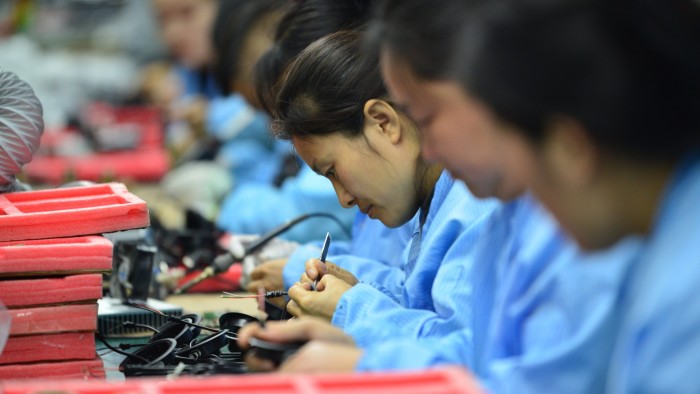US President Donald Trump’s announcement this month of “liberation day” tariffs drew disbelief from America’s trading partners and mockery from Chinese internet users.
Viral, artificial intelligence-generated videos depicting American workers sweating over trainer and smartphone assembly lines circulated on Chinese social media, after Trump claimed that “jobs and factories will come roaring back” to the US as a result of the tariffs.
The videos highlighted that there is little chance of the US replicating the labour force advantages that turned China into the world’s factory over more than two decades — even if the tariffs, a declining working-age population and companies shifting production to other countries are now calling some of those advantages into question.
“China has a unique set of factors that make it the world’s best place to manufacture so much of what we consume,” said Joshua Woodard, founder of Shenzhen-based supply chain consultancy The Sparrows.
“There is a completely different expectation for the working culture,” added Woodard. “Migrant workers are motivated to spend 12 hours in the factory to send as much money back home as possible.”
China’s export-oriented manufacturing industry began to grow in the 1980s due in part to its abundant supply of affordable labour, much of it from rural migrant workers who relocated from inland cities to coastal cities.
Later, it cemented that position with efficient supply chains and engineering prowess, making it a fast and cost-effective place to source goods, particularly after China joined the World Trade Organization in 2001.

Increasingly though, factory managers say it is becoming difficult to attract a new generation of workers to physically intensive manufacturing jobs, which offer long hours and low pay.
They added that the dwindling labour force — a reflection of China’s ageing population — had given workers some measure of bargaining power.
“Good workers are hard to find and they are getting older,” said a manager in Suzhou named Xu. “If the factories pay too low, they will not negotiate as a labour union but vote with their feet.”
Lu Junhua, an 18-year-old worker from Jiangsu province, said he had already quit two factory jobs since arriving several months ago in Chang’an, a town in Guangdong province known for its electronics industry.
He said workers’ dormitories, which slept seven people per room, were dirty and lacked air conditioning and hot water. He was paid an hourly wage of Rmb15 ($2.05), with at least 10-hour shifts six days a week, resulting in pain in his hands and lower back. The work “exhausts your spirit”, he said.
Labour regulations are inconsistently enforced and many workers lack the legal protections and negotiating powers afforded by trade unions. “Multinational brands may not know their suppliers are making their workers work 12 hours a day, seven days a week,” said Han Dongfang, founder of China Labour Bulletin, which advocates for workers’ rights.
Many young Chinese workers are now shunning the factory floor for the service sector, filling positions such as delivery drivers and restaurant workers in the 200mn-strong informal gig economy.
Social media platforms such as Douyin, the Chinese sister app of TikTok, and Kuaishou have also become an important resource for labourers to share insights on which factories to avoid — and which offered better conditions.
Mary Hong, a former worker at a Foxconn iPhone factory in Henan province, said the Taiwanese Apple supplier was a cut above other local plants. “The working environment was good,” she said. “The dormitory has air conditioning and hot water 24 hours a day. The workshop is temperature controlled.”
Given increasing costs as workers have demanded better conditions and factories have graduated to higher-value sectors such as cars, many labour-intensive industries have already begun to shift production of low-cost goods to countries such as Vietnam, Malaysia and Bangladesh, where labour is cheaper.
In 2009, average manufacturing labour costs were almost 20 per cent lower in China than in Malaysia. Now, they are about 30 per cent higher, according to Frederic Neumann, chief Asia economist at HSBC.
That shift has been accelerated as companies have pursued a “China plus one” strategy to protect their supply chains from geopolitical disruption.

The Trump administration has said that the wide range of its tariffs are intended in part to pressure third countries to crack down on “transshipment” of Chinese goods to evade the levies.
For those “third countries”, the challenges of displacing China as the world’s manufacturing centre are in any case considerable.
Many, such as Vietnam and India, boast large, young populations but lack the integrated infrastructure, skilled workforce and supply chain logistics that China has developed over the previous decades that made it such an efficient hub for manufacturing.
Some are now looking to replicate the dormitory system that supported China’s manufacturing boom.
Recommended
But moving that industry back to the US would run into insurmountable cultural barriers, Chinese factory workers said.
Huang Sheng, a 33-year-old factory recruiter in Chang’an who spent nearly a decade working in lighting plants, poured scorn on Trump’s idea that Americans would take up manufacturing jobs.
“With our overtime system, 14 hours a day is very normal,” he said. “A lot of countries wouldn’t be able to stomach it.”




